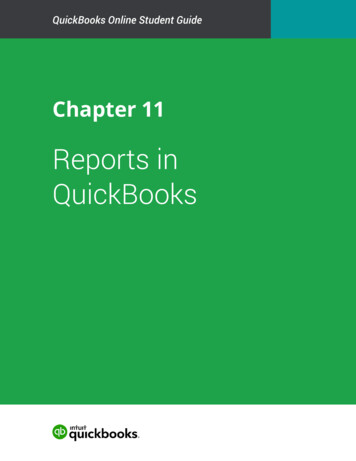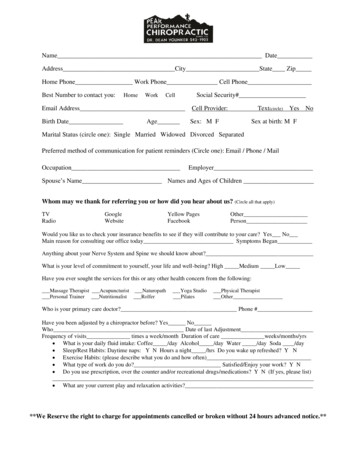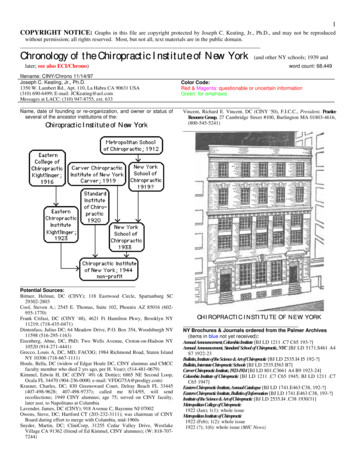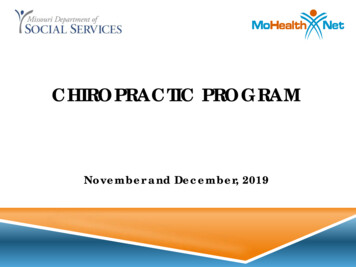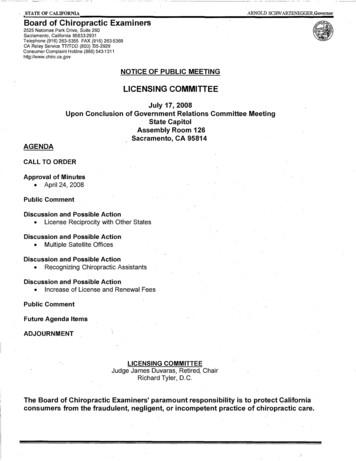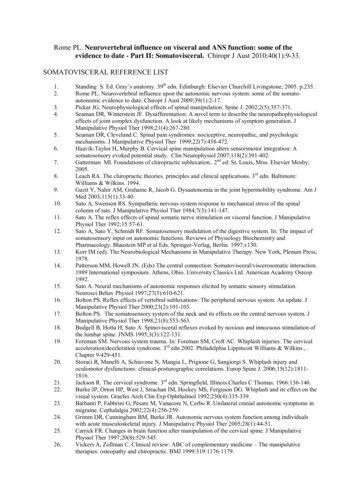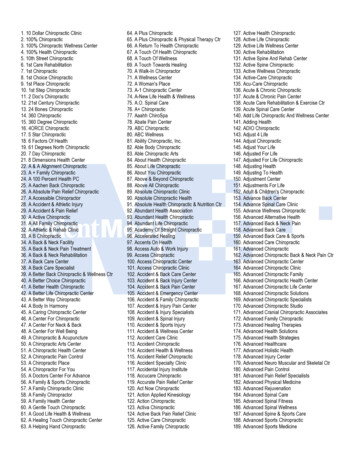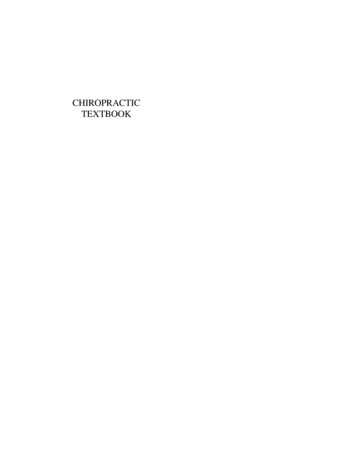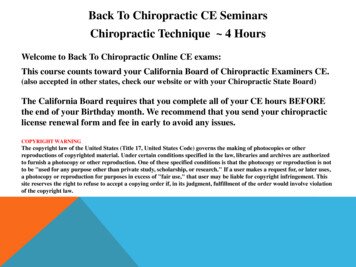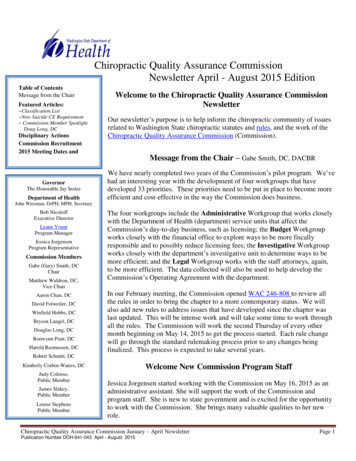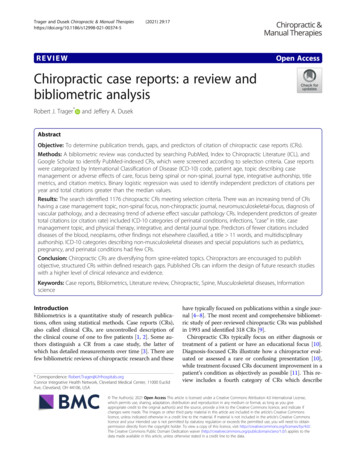
Transcription
Trager and Dusek Chiropractic & Manual 5(2021) 29:17REVIEWOpen AccessChiropractic case reports: a review andbibliometric analysisRobert J. Trager*and Jeffery A. DusekAbstractObjective: To determine publication trends, gaps, and predictors of citation of chiropractic case reports (CRs).Methods: A bibliometric review was conducted by searching PubMed, Index to Chiropractic Literature (ICL), andGoogle Scholar to identify PubMed-indexed CRs, which were screened according to selection criteria. Case reportswere categorized by International Classification of Disease (ICD-10) code, patient age, topic describing casemanagement or adverse effects of care, focus being spinal or non-spinal, journal type, integrative authorship, titlemetrics, and citation metrics. Binary logistic regression was used to identify independent predictors of citations peryear and total citations greater than the median values.Results: The search identified 1176 chiropractic CRs meeting selection criteria. There was an increasing trend of CRshaving a case management topic, non-spinal focus, non-chiropractic journal, neuromusculoskeletal-focus, diagnosis ofvascular pathology, and a decreasing trend of adverse effect vascular pathology CRs. Independent predictors of greatertotal citations (or citation rate) included ICD-10 categories of perinatal conditions, infections, “case” in title, casemanagement topic, and physical therapy, integrative, and dental journal type. Predictors of fewer citations includeddiseases of the blood, neoplasms, other findings not elsewhere classified, a title 11 words, and multidisciplinaryauthorship. ICD-10 categories describing non-musculoskeletal diseases and special populations such as pediatrics,pregnancy, and perinatal conditions had few CRs.Conclusion: Chiropractic CRs are diversifying from spine-related topics. Chiropractors are encouraged to publishobjective, structured CRs within defined research gaps. Published CRs can inform the design of future research studieswith a higher level of clinical relevance and evidence.Keywords: Case reports, Bibliometrics, Literature review, Chiropractic, Spine, Musculoskeletal diseases, InformationscienceIntroductionBibliometrics is a quantitative study of research publications, often using statistical methods. Case reports (CRs),also called clinical CRs, are uncontrolled description ofthe clinical course of one to five patients [1, 2]. Some authors distinguish a CR from a case study, the latter ofwhich has detailed measurements over time [3]. There arefew bibliometric reviews of chiropractic research and these* Correspondence: Robert.Trager@UHhospitals.orgConnor Integrative Health Network, Cleveland Medical Center, 11000 EuclidAve, Cleveland, OH 44106, USAhave typically focused on publications within a single journal [4–8]. The most recent and comprehensive bibliometric study of peer-reviewed chiropractic CRs was publishedin 1993 and identified 318 CRs [9].Chiropractic CRs typically focus on either diagnosis ortreatment of a patient or have an educational focus [10].Diagnosis-focused CRs illustrate how a chiropractor evaluated or assessed a rare or confusing presentation [10],while treatment-focused CRs document improvement in apatient’s condition as objectively as possible [11]. This review includes a fourth category of CRs which describe The Author(s). 2021 Open Access This article is licensed under a Creative Commons Attribution 4.0 International License,which permits use, sharing, adaptation, distribution and reproduction in any medium or format, as long as you giveappropriate credit to the original author(s) and the source, provide a link to the Creative Commons licence, and indicate ifchanges were made. The images or other third party material in this article are included in the article's Creative Commonslicence, unless indicated otherwise in a credit line to the material. If material is not included in the article's Creative Commonslicence and your intended use is not permitted by statutory regulation or exceeds the permitted use, you will need to obtainpermission directly from the copyright holder. To view a copy of this licence, visit http://creativecommons.org/licenses/by/4.0/.The Creative Commons Public Domain Dedication waiver ) applies to thedata made available in this article, unless otherwise stated in a credit line to the data.
Trager and Dusek Chiropractic & Manual Therapies(2021) 29:17adverse effects of chiropractic care, the inclusion of whichwill aid in the completeness of the bibliometric analysis.Chiropractic interest in CRsAlthough few chiropractors conduct research, manyare interested in doing so. One United States-basedstudy found that 27% of chiropractic students plannedon conducting and publishing some form of research[12], and a 2011 survey of the American ChiropracticAssociation members found that 60% reported aninterest in conducting research [13]. Despite thisinterest, only about 2–6% of chiropractors internationally have published or are engaged in researchactivities [14–16]. Notwithstanding, two reviews specific to chiropractic journals found that CRs were themost frequently published form of chiropractic research [5, 6] and thus may serve as an entry pointinto research for chiropractors.Accordingly, multiple chiropractic editorials and commentaries have encouraged students and clinicians topublish CRs [8, 11, 17–25]. These and other publicationshave provided detailed instructions for chiropractors onhow to write CRs [8, 10, 11, 26–29]. Authors promotingchiropractic CRs have described motivations to publishCRs that are more specific to the profession whichinclude: To increase the chiropractic research database [10,19, 27] To increase awareness of chiropractic in thescientific and healthcare community [19] To improve inter-professional relationships [19] To stimulate intra-professional collaborations [22] Important clinical observations are goingunpublished [22] or treatment effects only haveanecdotal support [9, 11, 30] To present the case management of nonmusculoskeletal, non-spinal disorders [17, 18] To focus on populations with a limited researchbase such as pediatric patients [18, 25] and pregnantwomen [25] To help other clinicians with similar cases [11, 18,21, 22, 25]Strengths of this reviewTo our knowledge, no prior studies have subcategorizeda broad range of chiropractic CRs or investigated predictors of chiropractic CR citation rates.Purpose of this reviewPage 2 of 19category, patient age, topic being case managementor adverse effects, focus being spinal or non-spinal,journal type, and integrative authorship.(2) Summarize citation data for chiropractic CRs withreference to the above listed variables and titlemetrics.(3) Perform a multiple logistic regression to identifyindependent variables associated with greatercitations of chiropractic CRs.MethodsSearch strategyTest searches were conducted using PubMed, MicrosoftAcademic Search, the Index to Chiropractic Literature,EbscoHost, Google Scholar, and Google Scholar usingHarzing’s Publish or Perish 7 (Tarma Software ResearchLtd. ) to refine the search terms and identify the most accurate and time-saving search strategy. Prior researchershave recommended searching both PubMed/MEDLINE and a chiropractic database (ICL or MANTIS/Chirolars)when conducting chiropractic research because no singledatabase will return all relevant results [31].In test searches, PubMed returned fewer CRs than expected based on the amount indexed in ICL. CertainCRs that appeared in ICL, but not the PubMed testsearches, could be secondarily identified on PubMed bydirectly searching for the CR title. Conversely, therewere CRs in PubMed that did not appear in ICL, such asthose published in general medical journals, CR journals,or physical therapy journals.A preliminary search of EBSCOhost was performed tocompare the number of CRs relative to other health disciplines and these CRs were not screened for inclusion intothe review. This database enables sorting CRs by specialty.Using the “Advanced Search” options, under “PublicationType” the option “Case Study” was selected (which includes CRs), and results were searched for each categoryunder the “Special Interest” section on 8/25/2020.Ultimately, three databases were searched for inclusionof CRs into this review: PubMed, ICL, and GoogleScholar (Table 1). Search results were downloaded tocomma-separated value files and combined into aMicrosoft Excel workbook. Articles excluded with specific reasons were recorded in a separate sheet.The search of ICL was performed to identify PubMedindexed CRs that were not found in the initial PubMedsearch. The advanced search function was set to Articletype: “Case report,” and “Peer Reviewed articles.” Articles were included provided they were indexed onPubMed and met the other selection criteria.The aims of this review are to:Selection criteria(1) Identify trends and gaps in the research forchiropractic CRs by examining ICD-10 diseaseA broad range of types of CRs were included in this study, asdescribed in a prior article [3], including retrospective cases,
Trager and Dusek Chiropractic & Manual Therapies(2021) 29:17Page 3 of 19Table 1 Search strategyDatabaseDate of searchCriteriaIndex to chiropractic literature (ICL)10/30/2020Article type: Case report, Peer stract]) OR (chiropract*[Affiliation]))OR (chiropractic [MeSH Terms])Article type: Case report772Google Scholar using Harzing’sPublish or Perish10/30/2020Keywords: “case report” chiropracticFirst 100 results screenedEBSCOhost8/25/2020Publication type: Case studySpecial interest: Chiropractic Care609N-of-1 studies, single subject trials, and case studies, providedthey met the selection criteria listed below. The broad rangeof study descriptions in our inclusion criteria was purposefuland intended to account for variation in terminology used todescribe such cases. In addition, the terms “case study” and“case history” map to “case reports” in Medical SubjectHeadings in PubMed [3] and were identified using the searchstrategy. Additional inclusion criteria were the reporting of(1) patient age, (2) sex and (3) relation to any aspect of chiropractic diagnosis, treatment, or case management.Exclusion criteria were studies that had more than 5patients, non-human subjects, were anatomical-cadaverstudies, and mentioned chiropractic but were unrelatedto chiropractic diagnosis or management, or the association was unclear. This criterion was necessary as previous research has highlighted that the terms“chiropractor” or “chiropractic manipulation” are oftenmisused in published CRs describing adverse responsesto therapies [32, 33]. This review utilized these priorpublications to aid in the exclusion of CRs that used inappropriate terminology. Studies that examined themechanisms of a diagnostic or treatment method onasymptomatic volunteer(s) were also excluded.Utilization of a quality checklist such as the CARE(CAse REports) guidelines [34] was beyond the scope ofthis review.PubMed indexing of CRs was a prerequisite in thisstudy as a means of standardizing the selection of CRs.Although there is an overlap of “peer-reviewed” and“PubMed-indexed” CRs, some chiropractic journals publish peer-reviewed CRs that are not PubMed indexed,for example the Journal of Clinical ChiropracticPediatrics.ICD-10 categoryGrouping CR disease by ICD-10 blocks [35] (Table 2),also called categories, has been recommended as ameans to categorize CRs for further analysis [36]. Casereports were assigned the best-matching ICD-10 category code [37] which was identified by entering the primary CR diagnosis into a search engine [38]. Whenthere was no exact match for a diagnosis, a Googlesearch was performed to find the most applicable ICD-Initial resultsTable 2 ICD-10 categories used in this bibliometric analysisBlockTitleA00–B99Certain infectious and parasitic diseasesC00–D48NeoplasmsD50–D89Diseases of the blood and blood-forming organs and certaindisorders involving the immune mechanismE00–E90 Endocrine, nutritional and metabolic diseasesF00–F99 Mental and behavioural disordersG00–G99Diseases of the nervous systemH00–H59Diseases of the eye and adnexaH60–H95Diseases of the ear and mastoid processI00–I99Diseases of the circulatory systemJ00–J99Diseases of the respiratory systemK00–K93 Diseases of the digestive systemL00–L99 Diseases of the skin and subcutaneous tissueM00–M99Diseases of the musculoskeletal system and connective tissueN00–N99Diseases of the genitourinary systemO00–O99Pregnancy, childbirth and the puerperiumP00–P96 Certain conditions originating in the perinatal periodQ00–Q99Congenital malformations, deformations and chromosomalabnormalitiesR00–R99 Symptoms, signs and abnormal clinical and laboratoryfindings, not elsewhere classifiedS00–T98 Injury, poisoning and certain other consequences of externalcausesV01–Y98 External causes of morbidity and mortalityZ00–Z99 Factors influencing health status and contact with healthservicesU00–U99Codes for special purposes
Trager and Dusek Chiropractic & Manual Therapies(2021) 29:1710 code. When a patient presented with spinal complaint and another systemic complaint, the non-spinalcomplaint took precedence and was cataloged by ICD10 category. For CRs describing an adverse effect ofchiropractic care, the resulting effect was coded (e.g.fracture) rather than the patient’s presenting complaint(e.g. headache) or V code (external causes of morbidityand mortality). For case series with up to 5 patients having heterogeneous ICD-10 diagnoses, the most frequentICD-10 category was used. Because there is no specificICD-10 code for cervicogenic vertigo, CRs describingimprovement of dizziness or vertigo after spinal manipulation were grouped within H60–H95. Cases describing“sports hernia” relating to tendinopathy were coded inthe M00-M99 category, and those relating to a muscletear in the S00-T98 category.Publications for each ICD-10 block were grouped byyear. These values were then graphed by percentage ofpublications as well as publication volume. The slope ofthe resulting trend line was used to identify publicationtrends, as has been done in prior studies [39, 40].Pediatric casesCase reports were defined as pediatric if the describedpatient(s) were age 16 or younger, to be consistent withthe U.S. Food and Drug Administration definition of apediatric range for research purposes [41]. For CRs withmultiple patients, the most common age bracket ofpediatric vs. non-pediatric was used. If there were aneven number of cases (1 or 2 each) of pediatric and nonpediatric, the pediatric determination was given.Adverse effects vs. case management topicCase reports were divided into two topics, (1) casemanagement-type, which included a diagnostic workup,clinical reasoning, or treatment approach, including integrative CRs, and (2) adverse effects, which includedmissed or delayed diagnoses resulting in an adverseevent, or more direct adverse events related to chiropractic care such as treatment-related injury. These datawere then graphed by publication year.Spinal versus non-spinal focusCase reports were divided into two groups, (1) those focusing on spine-related or sacrococcygeal-related symptoms and/or treatments, and (2) those that focused onextraspinal conditions, outside of the spine and sacrococcygeal region. Cases of infection, tumors, or otherdiseases presenting with spine or sacrococcygeal symptoms were considered spine-related. Cases of vertebralartery pathology or abdominal aortic aneurysm causingneck or back pain were considered spine-related. Casesof shoulder and hip pathology in which treatment included spinal manipulation were also considered spinal.Page 4 of 19Cases pertaining to rib symptoms or costochondritis thatdid not involve therapies directed to the costovertebralor costotransverse joints were considered extraspinal.Citation metricsCase report titles were entered into Google Scholar tocalculate the total number of citations. This was donemanually from 11/2/2020–11/3/2020. Citations per yearwere calculated using the formula [citations/(2020-(publication year))] as has been done in other studies [42].Citation metrics were used from Google Scholar asopposed to another database (such as PubMed) becausea larger scope of citation data was preferred to thoroughly examine the overall citation impact of CRs. Google Scholar records citations from a broader range ofsources including the grey literature as well as book citations, and finds nearly all citations identified by Web ofScience and Scopus [43].Journal metricsJournal names were extracted from the database of selected CRs, sorted alphabetically, and duplicates were removed. Journals were cataloged using a code based onthe focus of the journal, which was chosen based on thejournal website description and/or mission statement.This system grouped journals into the following categories: medical, chiropractic or alternative and complementary medicine, radiology, physical therapy, integrative,CR, dental, and other. Neurology, surgery, and familymedicine journals were cataloged as medical journals.Neuroradiolgy and diagnostic ultrasound journals weregrouped with radiology journals. Journal H-index valueswere identified using SCImago Journal & Country Rank[44]. This value correlates with the Impact Factor (IF)and SCImago Journal Rank indicator (SJR) [45] and wasused because certain journals did not have an assignedSJR or IF, while the H-index is freely available and canbe easily found or calculated [46].Author names were extracted from the database of selected CRs by delimiting to surname and initial(s), and duplicates were deleted. Some author names had multiplevariations which was manually corrected (e.g. Chu ECPand Chu EC). Precautions were taken to avoid combiningdistinct authors (e.g. Jocelyn Cox and James M. Cox).Further data were gathered for authors publishing inthe top ten list of publication volume. Author H-indiceswere identified on 11/2/2020 using the authors’ GoogleScholar profile. When this was not available, the authorname was searched using Google Scholar via Harzing’sPublish or Perish tool with the additional keyword“chiropractic,” as these authors had a chiropractic degreeor affiliation. Affiliations were extracted from the CRabstract or full-text.
Trager and Dusek Chiropractic & Manual Therapies(2021) 29:17Integration metricsAuthor degrees were identified for all non-chiropracticauthors by searching the full-text of the CR, crossreferencing the author name with other publications,ResearchGate, ICL, or the researcher’s website or academic institution. Authors with a medical degree, but noidentifiable specialty were recorded as having an “unlisted specialty.” In instances where an author obtained anon-chiropractic health degree after the CR publicationdate, the degree was not listed.Case reports were recorded as having integratedauthorship or single-discipline authorship. To be considered “integrated,” authors had to have different healthcare-related degrees related to patient care. These included medical and osteopathic degrees as well as alliedhealth professions (e.g. physical therapy, nursing). APhD author was not considered integrated for the purposes of this review. Case reports by a single author withdual degrees (e.g. DC and MD) were not considered integrated. Multi-author papers with at least one DC and aDC author who had an additional degree such as an RNor MD were considered integrated.Page 5 of 19and (2) citations per year were tested for a normal distribution by creating a histogram and by using the Kolmogorov–Smirnov test, which yielded an Asymp. sig (2tailed) of 0.001 for both, indicating a non-normaldistribution.Prior research on citation impact has recommendedcomparing the number of citations to the median value[50]. Other research has suggested using citations peryear rather than total citations, to adjust for differencesin publication year [42]. We used two models with a different independent variable for each: (1) 7 total citations ( median value), and (2) 0.6 citations per year( median value). Odds ratios (ORs) with confidence intervals were calculated for each variable.The following covariates were included in the logisticregression: ICD-10 category, pediatric subject, adverseeffect or co-management topic, spinal or non-spinalfocus, journal type, integrative authorship, and title metrics including presence of a colon (:), presence of thestem “case,” and number of words 11.ResultsSearch resultsTitle metricsThe number of words and presence of a colon punctuation in each CR title was recorded using Excel countingformulas. Title length and colon punctuation has beenidentified by prior research to impact citation metrics[47]. Case reports were denoted that used the word stem“case” in the title or any of its derivations including“cases,” “case study,” or “case report,” a measure basedon the CARE guidelines [34].KeywordsA key phrase finder [48] was used to identify occurrences of common 2-word phrases, to further clarify CRtopic and focus.The search strategy identified 3076 records which wasreduced to 1176 after the removal of duplicates and application of selection criteria (Fig. 1). The final list ofCRs and those excluded by screening are available uponrequest.There were fewer chiropractic CRs relative to otherhealth disciplines or special interests as indexed by EBSCOhost (Fig. 2). For example, chiropractic CRs wereoutnumbered by pediatric care CRs by a factor of 25:1.This comparison had limitations in that EBSCOhostdoes not provide a comprehensive list of healthcare specialties, some chiropractic-authored CRs could havebeen categorized under physical therapy or other specialinterests, and this database returned fewer chiropracticCRs than PubMed or ICL.Logistic regressionBivariate logistic regression was performed using GNUPSPP Statistical Analysis Software version 1.0.1. Regression is recommended as the most powerful method ofidentifying variables affecting article citations [49]. Logistic regression can be used when the distribution of citations is non-normal, to predict papers belonging to ahighly cited group [49]. A cutoff p-value of 0.05 wasused to denote statistical significance.Prior to logistic regression, testing was performed forbivariate correlation using a two-tailed Pearson correlation matrix to identify strongly associated variables.None of the variables had a correlation coefficient of 0.7or higher, except citations and citations per year (0.7,p 0.001), which were analyzed in separate regressionmodels. In addition, the number of (1) total citationsICD-10 categoryDiseases of the musculoskeletal system and connective tissue (M00-M99) had the greatest volume of CRs (Fig. 3),representing 37.7% of identified CRs. Consistent with thisfinding was that the most common 2-word phrases hadmusculoskeletal associations including “back pain” (87 occurrences), “low back” (70), and “cervical spine” (46). Thenext most common phrase was “vertebral artery” (37 occurrences) which belonged to Diseases of the circulatorysystem (I00-I99). There were no CRs in the ICD-10 blocksV01–Y98, Z00–Z99, and U00–U99.Certain conditions originating in the perinatal period(P00-P96) were represented by four CRs, the least of anycategory, with the first published in 1993, describingtreatment for Erb’s palsy [51]. Others in this category
Trager and Dusek Chiropractic & Manual Therapies(2021) 29:17Page 6 of 19Fig. 1 Preferred Reporting Items for Systematic Reviews and Meta-Analyses (PRISMA) flowchartdescribed chiropractic management of breast-feedingdifficulties [52] and gastroesophageal reflux in an infant[53]. Conditions of pregnancy, childbirth and the puerperium (O00-O99), a related ICD-10 category, likewisehad few CRs. The first, published in 1995, was writtenby nurse midwife and described successful chiropracticmanipulation of the pelvis to treat sciatica which developed during labor [54]. Other CRs in this category described the management of pregnancy-related pubicsymphysis pain [55], lumbar radiculopathy [56], andmeralgia paresthetica [57].ICD-10 trendsThe rank of publication trends for the top two for casemanagement and adverse effects CRs remained identicalwhen trends for publication volume were analyzed rather than publication percentage, which is what ispresented.The ICD-10 categories with the greatest positive publication trend for case management CRs were Musculoskeletal and connective tissue diseases (M00-M99),followed by Injury, poisoning and certain other consequences of external causes (S00-T98) and Diseases ofthe nervous system (G00-G99) (Table 3). These categories contain neuromusculoskeletal diagnoses, includingspinal pain and radiculopathy (M codes), myelopathy (Gcodes) and sprains and strains (S00-T98).Additional trends were identified for case managementCRs with the highest citation rate since 2015. Musculoskeletal and connective tissue (M00-M99) CRs includedan integrative series describing platelet rich plasma injections for sacroiliac joint instability [58], and CRs describing the Chiropractic BioPhysics methods forposture [59], cervical whiplash [60], and scoliosis [61].Diseases of the nervous system (G00–G99) CRs described management of postoperative spinal arachnoiditis [62], rehabilitative techniques for a patient withposterior cortical atrophy [63], and integrative management of an incomplete cervical spinal cord injury [64].Injury, poisoning and certain other consequences of external causes (S00-T98) CRs included multidisciplinarymanagement of inguinal/abdominal muscle strains in a
Trager and Dusek Chiropractic & Manual Therapies(2021) 29:17Page 7 of 19Fig. 2 Case report volume indexed by EBSCOhost according to special interest on August 25th, 2020. Select interest groups are shown. Nursinglanguage / classification, case management, nursing administration, nursing education, informatics, and quality assurance are not shown, whichhad fewer CRs than chiropractic, while evidence-based practice, advanced nursing practice, palliative/hospice care, and social work are also notshown, which had a greater number of CRs than chiropractichockey player [65], soft tissue therapy post knee-surgery[66], and diagnostic ultrasonography for lateral ankle injury [67].Case management CRs in the fourth-fastest growingcategory, Diseases of the circulatory system (I00-I99),began with the first publication in 1986 [68], with theFig. 3 Volume of chiropractic case reports by ICD-10 categoryyearly volume peaking in 2014. Examples include CRs inwhich chiropractors suspected and referred patients withvertebral artery dissection [69–71], ischemic stroke [72],hemorrhagic stroke [73], upper [74, 75] and lower [76,77] extremity deep vein thrombosis, abdominal aorticaneurysm [68, 78–81], intracranial aneurysm [82],
Trager and Dusek Chiropractic & Manual Therapies(2021) 29:17Table 3 Trend in ICD-10 category grouped by CR topic, as apercentage of total articles in each respective topicCase managementAdverse effectPage 8 of 19Spine vs. non-spinal focusThere was an overall gradual decrease in the percentageof spine-related CRs, and conversely, an increase in nonspine-related CRs (Fig. 5). The 5-year mean proportionof spine-related CRs has reduced from 92% in 1980 to79% in 1990 to 68% in -H950.0000Journal –Q990.000014A00-B99 0.0002D50-D890.000015Q00–Q99 0.0002H00-H590.000016F00-F99 0.0011C00-D48 0.000517M99-M99 0.0014E00-E90 0.001418J00-J99 0.0014H60-H95 0.002619I00-I99 0.0040Chiropractic CRs were published in 186 unique journals.The majority of chiropractic CRs (852 CRs or 72% oftotal), regardless of topic or focus, were published inthree journals, the Journal of Manipulative and Physiological Therapeutics, the Journal of the Canadian Chiropractic Association, and the Journal of ChiropracticMedicine. Chiropractic journals had published eight adverse effect topic CRs representing 0.9% of their totalCRs while medical journals published 164, representing85% of their total CRs. The medical journal with thegreatest number of published chiropractic CRs wasNeurology, which published six, all of which describedadverse effects.Prior to the 1980s most chiropractic CRs were published in medical journals, with 79% of these CRs describing an adverse effect. From 1984 to 2020 mostchiropractic CRs were published in chiropractic-focusjournals (Fig. 6). Publication in chiropractic journals hasreduced as a percentage of total CRs since 2017 (70% in2017, 62% in 2018, 59% in 2019).Since 2015, three journal types have emerged withincreasing CR volume: physical therapy, integrativemedicine, and dedicated CR journals (Fig. 7). From2018 to 2020, these have combined to publish up to28% of chiropractic CRs. The most published physicaltherapy journal was J Phys Ther Sci (13 of 16 in thatjournal type), integrative medicine was EXPLORE(NY) (4 of 11), and CR journal was tied betweenAME Case Rep and BMJ Case Rep (3 each of 9).H-indices were readily available using SCImago for163 out of 186 Journals. The remainder were calculatedvia Google Scholar using Harzing’s Publish or Perish.popliteal aneurysm [83], myocardial infarction [84] andsubdural hematoma [85].The ICD-10 categories with the greatest positive publication trend in the adverse effect topic were Injury, poisoning and certain other consequences of externalcauses (S00-T98) and Diseases of the nervous system(G00-G99). In contrast, Diseases o
a broad range of chiropractic CRs or investigated predic-tors of chiropractic CR citation rates. Purpose of this review The aims of this review are to: (1) Identify trends and gaps in the research for chiropractic CRs by examining ICD-10 disease category, patient age, topic being case management or adverse effects, focus being spinal or non-spinal,

